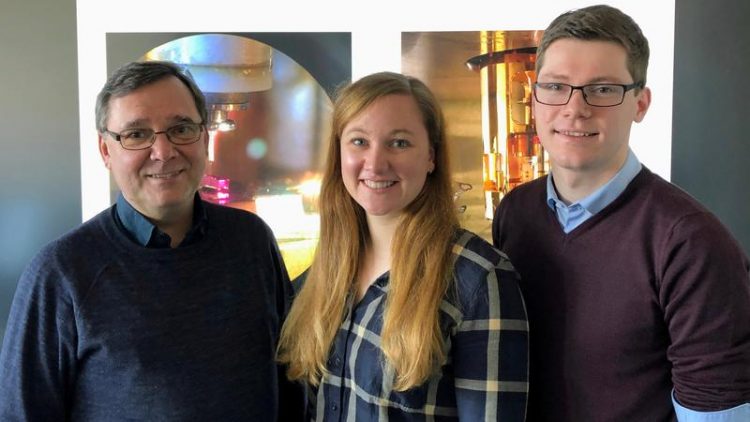It’s closeness that counts: how proximity affects the resistance of graphene

Dr Martin Wenderoth, Anna Sinterhauf and Georg A Traeger with pictures of the scanning tunnelling microscopes in the background. Photo: Benno Harling, University of Göttingen
Contrary to previous assumptions, the new results show that the process known as the ‘proximity effect’ varies considerably at a nanometre scale. The results have been published in Nature Communications.
The composition of graphene is very simple. It is a single atomic layer of carbon atoms arranged in a honeycomb structure. The three-dimensional form is already an integral part of our everyday lives: we see it in the lead of an ordinary pencil for instance.
However, the two-dimensional material graphene was not synthesized in the laboratory until 2004. To determine the electrical resistance of graphene at the smallest scale possible, the physicists used a “scanning tunnelling microscope”.
This can make atomic structures visible by scanning the surface with a fine metal tip. The team also used the tip of the scanning tunnelling microscope to measure the voltage drop and thus the electrical resistance of the tiny graphene sample.
Depending on the distance that they measured, the researchers determined very different values for the electrical resistance. They cite the proximity effect as the reason for this.
“The spatially varying interaction between graphene and the underlying crystal means that we measure different electrical resistances depending on the exact position,” explains Anna Sinterhauf, first author and doctoral student at the Faculty of Physics at the University of Göttingen.
At low temperatures of 8 Kelvin, which is around minus 265 degrees Centigrade, the team found variations in local resistance of up to 270 percent.
“This result suggests that the electrical resistance of graphene layers epitaxially grown on a crystal surface cannot simply be worked out from an average taken from values measured at a larger scale,” explains Dr Martin Wenderoth, head of the working group. The team assumes that the proximity effect might also play an important role for other two-dimensional materials.
Dr Martin Wenderoth
University of Göttingen
Faculty of Physics – IV Physical Institute
Friedrich-Hund-Platz 1, 37077 Göttingen, Germany
Tel: +49 (0) 551 39-29367
Email: martin.wenderoth@uni-goettingen.de
http://www.uni-goettingen.de/en/500611.html
Anna Sinterhauf et al. Substrate induced nanoscale resistance variation in epitaxial graphene. Nature communications (2020). http://www.nature.com/articles/s41467-019-14192-0
Media Contact
All latest news from the category: Physics and Astronomy
This area deals with the fundamental laws and building blocks of nature and how they interact, the properties and the behavior of matter, and research into space and time and their structures.
innovations-report provides in-depth reports and articles on subjects such as astrophysics, laser technologies, nuclear, quantum, particle and solid-state physics, nanotechnologies, planetary research and findings (Mars, Venus) and developments related to the Hubble Telescope.
Newest articles

Sea slugs inspire highly stretchable biomedical sensor
USC Viterbi School of Engineering researcher Hangbo Zhao presents findings on highly stretchable and customizable microneedles for application in fields including neuroscience, tissue engineering, and wearable bioelectronics. The revolution in…

Twisting and binding matter waves with photons in a cavity
Precisely measuring the energy states of individual atoms has been a historical challenge for physicists due to atomic recoil. When an atom interacts with a photon, the atom “recoils” in…

Nanotubes, nanoparticles, and antibodies detect tiny amounts of fentanyl
New sensor is six orders of magnitude more sensitive than the next best thing. A research team at Pitt led by Alexander Star, a chemistry professor in the Kenneth P. Dietrich…





















